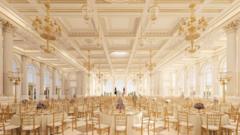The White House is set to undergo a significant upgrade with the initiation of a $200 million project to build a new ballroom, fulfilling President Donald Trump's long-standing aspiration. Press Secretary Karoline Leavitt revealed that the donation for this endeavor will come from Trump alongside anonymous benefactors, and construction is expected to commence in September.
The planned ballroom will boast a seating capacity for 650 guests and will be integrated with an updated East Wing, currently housing the First Lady's office and other essential White House functions. Many White House events are presently held in the smaller East Room, accommodating only 200 attendees, thus necessitating the use of large tents for larger gatherings, which often include visiting world leaders.
Leavitt described the new ballroom as a "much needed and exquisite addition" that would not only enhance event hosting capabilities but also eliminate the need for "large and unsightly tents." The expected completion date is projected to be "long before" President Trump’s term concludes in January 2029.
Chief of Staff Susie Wiles emphasized the administration’s commitment to preserving the historical nature of the White House while creating a ballroom befitting both current and future generations. Aesthetically, the ballroom plans to reflect the architectural style of the White House, complete with ornately designed interiors featuring chandeliers and elaborate columns.
Historically, the White House has seen expansions to meet the requirements of sitting Presidents. Leslie Greene Bowman, a member of the Committee for the Preservation of the White House, expressed hope that the renovation respects the historical significance of the existing structure.
In light of this initiative, the offices in the East Wing, affected by the construction, will be temporarily relocated. Trump has previously expressed his dissatisfaction with makeshift arrangements for state dinners and large events, stating, “There's never been a President that's good at ballrooms. I'm good at building things.”
Reflecting on his ill-fated 2016 offer of $100 million to erect a ballroom during Obama’s presidency, Trump remarked on the aesthetic challenges of using tents for official state events. He confidently stated during a recent Scotland meeting, “No president knew how to build a ballroom,” showcasing his self-proclaimed expertise in construction.
While Trump’s contributions to the White House’s physical appearance have been met with mixed responses, the ballroom project underscores a significant shift in the venue's event-hosting capabilities, positioning it for more prominent functions in the years to come.
The planned ballroom will boast a seating capacity for 650 guests and will be integrated with an updated East Wing, currently housing the First Lady's office and other essential White House functions. Many White House events are presently held in the smaller East Room, accommodating only 200 attendees, thus necessitating the use of large tents for larger gatherings, which often include visiting world leaders.
Leavitt described the new ballroom as a "much needed and exquisite addition" that would not only enhance event hosting capabilities but also eliminate the need for "large and unsightly tents." The expected completion date is projected to be "long before" President Trump’s term concludes in January 2029.
Chief of Staff Susie Wiles emphasized the administration’s commitment to preserving the historical nature of the White House while creating a ballroom befitting both current and future generations. Aesthetically, the ballroom plans to reflect the architectural style of the White House, complete with ornately designed interiors featuring chandeliers and elaborate columns.
Historically, the White House has seen expansions to meet the requirements of sitting Presidents. Leslie Greene Bowman, a member of the Committee for the Preservation of the White House, expressed hope that the renovation respects the historical significance of the existing structure.
In light of this initiative, the offices in the East Wing, affected by the construction, will be temporarily relocated. Trump has previously expressed his dissatisfaction with makeshift arrangements for state dinners and large events, stating, “There's never been a President that's good at ballrooms. I'm good at building things.”
Reflecting on his ill-fated 2016 offer of $100 million to erect a ballroom during Obama’s presidency, Trump remarked on the aesthetic challenges of using tents for official state events. He confidently stated during a recent Scotland meeting, “No president knew how to build a ballroom,” showcasing his self-proclaimed expertise in construction.
While Trump’s contributions to the White House’s physical appearance have been met with mixed responses, the ballroom project underscores a significant shift in the venue's event-hosting capabilities, positioning it for more prominent functions in the years to come.





















